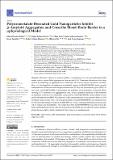Por favor, use este identificador para citar o enlazar a este item:
http://hdl.handle.net/10261/336500COMPARTIR / EXPORTAR:
 SHARE SHARE
 CORE
BASE CORE
BASE
|
|
| Visualizar otros formatos: MARC | Dublin Core | RDF | ORE | MODS | METS | DIDL | DATACITE | |

| Título: | Polyoxometalate-decorated gold nanoparticles inhibit β-amyloid aggregation and cross the blood–brain barrier in a µphysiological model |
Autor: | Perxés Perich, Marta; Palma-Florez, Sujey; Solé, Clara; Goberna-Ferrón, Sara CSIC ORCID; Samitier, Josep; Gómez-Romero, P. CSIC ORCID ; Mir, Mònica; Lagunas, Anna | Palabras clave: | Nanovehicle Gold nanoparticles Polyoxometalates β-amyloid Blood–brain barrier organ-on-a-chip |
Fecha de publicación: | 3-oct-2023 | Editor: | Multidisciplinary Digital Publishing Institute | Citación: | Nanomaterials 13(19): 2697 (2023) | Resumen: | Alzheimer’s disease is characterized by a combination of several neuropathological hallmarks, such as extracellular aggregates of beta amyloid (Aβ). Numerous alternatives have been studied for inhibiting Aβ aggregation but, at this time, there are no effective treatments available. Here, we developed the tri-component nanohybrid system AuNPs@POM@PEG based on gold nanoparticles (AuNPs) covered with polyoxometalates (POMs) and polyethylene glycol (PEG). In this work, AuNPs@POM@PEG demonstrated the inhibition of the formation of amyloid fibrils, showing a 75% decrease in Aβ aggregation in vitro. As it is a potential candidate for the treatment of Alzheimer’s disease, we evaluated the cytotoxicity of AuNPs@POM@PEG and its ability to cross the blood–brain barrier (BBB). We achieved a stable nanosystem that is non-cytotoxic below 2.5 nM to human neurovascular cells. The brain permeability of AuNPs@POM@PEG was analyzed in an in vitro microphysiological model of the BBB (BBB-on-a-chip), containing 3D human neurovascular cell co-cultures and microfluidics. The results show that AuNPs@POM@PEG was able to cross the brain endothelial barrier in the chip and demonstrated that POM does not affect the barrier integrity, giving the green light to further studies into this system as a nanotherapeutic. | Versión del editor: | https://doi.org/10.3390/nano13192697 | URI: | http://hdl.handle.net/10261/336500 | DOI: | 10.3390/nano13192697 | E-ISSN: | 2079-4991 |
| Aparece en las colecciones: | (CIN2) Artículos (ITQ) Artículos |
Ficheros en este ítem:
| Fichero | Descripción | Tamaño | Formato | |
|---|---|---|---|---|
| nanomaterials-13-02697.pdf | 1,03 MB | Adobe PDF |  Visualizar/Abrir |
CORE Recommender
Page view(s)
29
checked on 15-may-2024
Download(s)
14
checked on 15-may-2024
Google ScholarTM
Check
Altmetric
Altmetric
Este item está licenciado bajo una Licencia Creative Commons

